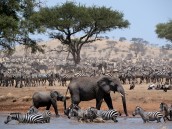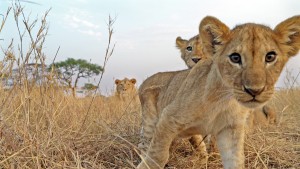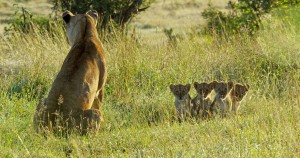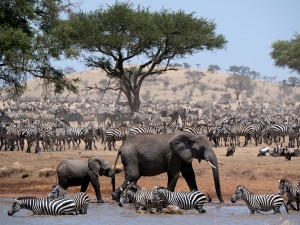Discovery Channel’s new Sunday-night miniseries SERENGETI is unusual. This is not because it is set in the Serengeti National Park in Tanzania, Africa, which contains large populations of many of the continent’s most notable wildlife; the network has aired many documentaries made there. However, SERENGETI is not a documentary, but rather a drama, created by Simon Fuller and directed by award-winning wildlife documentarian John Downer, both of whom are producers on the miniseries. Downer shot footage of real Serengeti lions, elephants, hyenas, baboons and other animals going about their lives, which has been edited into a storyline, narrated in the U.S. edition by Lupita Nyong’o and in the U.K. edition by John Boyega.
London-born filmmaker and author Downer has photographed and filmed an enormous variety of animals, both wild and domestic. He is known for his SPY IN THE WILD programs, which plant unobtrusive cameras (sometimes disguised as animatronic animals) among groups of polar bears, dolphins, wildebeest and more to observe the creatures without disturbing them.
ASSIGNMENT X: When you start out, how do you decide which specific animals you want to follow you’re your cameras?
JOHN DOWNER: Well, there are certain star animals that inevitably people want to see, lions and cheetahs, elephants, and Africa is just full of them. So we wanted a balance between the iconic animals, and also the ones that are less well-known. So that’s where the baboons came in. And also, writing themselves into the script all of the time were mongooses and warthogs, providing comic relief and surprises. So as you see the main characters’ storylines progress, all these other characters are coming in. They were never totally planned, but they just interact. And that’s what’s great about SERENGETI, because everything is interacting all the time.
AX: But there are, relatively speaking, a lot of lions in the Serengeti. How did you decide which particular lions to focus on?
DOWNER: We knew SERENGETI had to be about families. In the past, it was always the male stories. That used to be natural history – the big male lion is the hero. But all the interest is in the female stories. And so we knew we wanted to tell the female stories. The lion pride is run by the females. The males may last there for three years maximum before they’re overthrown by another three or four males. But the one thing that’s stable is the females. So for the lions, there had to a female story. And with the elephants, the matriarchs, it has to be the female story. But we didn’t want it just to be females. So the story of a young adolescent male who has to leave this female world for the big world outside was a natural. A new baby comes in, you don’t want to have an adolescent male getting really boisterous with the females and everything else – he has to go. So before we even started, we knew we wanted to focus on those. But we didn’t quite know where the stories were going to go, and where it would take us. But at the core of it, it was always about families.
AX: So you were looking for lionesses with cubs, and then going, “Well, which one’s doing something interesting?”
DOWNER: Yeah, but more than that, we would focus on a female with cubs that we would return to every day for months and months and months, and we’d follow those storylines. So most of the events that happen were based on her story, and that was incredible. Because we wanted the animals to write the story, as much as possible. That female with cubs, as it continues in [Episode] 2, suddenly, this male from her pride is following her. We didn’t know why. And that became the big storyline that resolves quite extraordinarily at the end. At this one moment, she turns around and confronts this male. We’re not manipulating that story. Those stories are coming from what we film. We might add a scene, or we might use an incredible event that we’ve captured [of a similar-looking lion’s actions] that could have been that lion. You don’t know [if it’s the same lion], but you know that is lion behavior. But most of the time, SERENGETI is informed by the animals that we follow.
AX: So if, for example, you have footage of a chase, and you have great footage of your main animal running from Point A to Point B, but you don’t have footage of that animal running from point B to Point C, you sometimes use footage of a similar-looking animal of the same species running from point B to Point C as if it’s your main animal?
DOWNER: Yeah. Because it’s a drama, there’s a license that you have. Say you have wild dogs, and you’ve shot another pack, it doesn’t have to be the same wild dogs. It’s totally legitimate in terms of the drama to use animals which are lookalikes. But that’s not really what it was about, because it was about these incredible moments of behavior. So if you’re trying to explain the behavior, you need the footage that makes that. SERENGETI has this whole different style of storytelling than a documentary, and that’s why we were very clear how different it is. It’s based on the real lives of these animals.
But in a documentary, if you film this animal, it always, always is the same animal. But then, when an event happens [that is not captured on film], you have an issue. You’ve missed something quite significant in their life. And so then it becomes a disjointed story. That’s fine, but I think using a dramatic framing, you can tell a complete story that is actually doing something beyond, “Look at this, and we missed this bit, and we’ll have to guess what happened.” You can tell the story of a place in a way that is really faithful to the place, and faithful to the animals that live there, because events that have happened to one animal, or a very similar animal, are events that are happening, and can happen, to any animal. So you therefore get a bigger and a better understanding of the whole ecosystem than you might through pure documentary.
AX: Did you ever have anything where you thought, “Oh, we should alter the story a bit to include this incredible shot we got,” or anything where, “We have to change the storyline, because for this to make sense, we need this shot, and we don’t have it”?
DOWNER: Well, because SERENGETI was a drama, yes. Often, they were pivotal moments in the story that became really important. When we captured that, that might fill in a piece of the story jigsaw. We are creating a drama, so it has to have a narrative that you can follow. So we kept the script fluid. We might have this amazing event – “That will inform that bit of missing story.” And so that’s how we built it. We like to think that the animals are telling us their story. We didn’t try and force it, and we didn’t know exactly where they were going with our story, often. We went with a plan, and then the plan just changed and changed. And I think where I’m happiest is, we didn’t know even what the end scene was going to be. But when it happened, there was no other. I won’t say what the end scene was, but for the whole series, it kind of just brought everything full circle. And that’s the kind of magic of it. If you’re open to what you’re filming, what it’s telling you, then you can create something that transcends what you were expecting.
AX: In the main pride you’re following, there are a number of males. Is it unusual to have that many male lions in the same pride?
DOWNER: No, not at all. I think there were five on that one. That was quite big, but it can be eight – I’ve known eight. Three is quite common, four is quite common. It’s a coalition of males, so they’re always under threat from outsiders.
AX: Are they usually siblings or cousins?
DOWNER: The males that come in are often related, but they will meet other males to increase their power. They tend to be related.
AX: Did you shoot SERENGETI any differently than you would a documentary? Do you collect footage any differently?
DOWNER: Yeah. I’ve always tried to shoot, even for a documentary, from that animal viewpoint. So that hasn’t changed. What’s changed is that we were able to push the technology and the ways of filming beyond what we would normally do with the number of cameras. We might have four or five cameras in one vehicle, sometimes filming at the same time, but they were all getting different shots and different angles. There are things that you don’t usually use in a documentary, such as subjective viewpoints, and multiple angles on the same event. So we geared our whole camera systems to provide those multiple viewpoints. And, as I say, there’s a subjective style that you would normally only see in human drama, and we’re applying that to the natural world. And so it becomes a whole different experience, and it’s a heightened experience. But then, that world really is a heightened experience. So what we’re trying to do is capture the reality of being there.
AX: Did you ever run into any human interference, unhappy locals, or hunters, or just government people asking, “Who are you?”
DOWNER: There’s an amazing reserve that joins the national park. It was so well-protected. There is low-level poaching – when I say “low-level poaching,” it’s normally for meat – but that does affect the whole ecology. But the way that place is run is quite extraordinary in that the local people are employed to police that park, and therefore the people are invested in it, and invested in the success of it, because they’re earning a living from it, and they understand the value of those animals. We met very briefly some poachers once, and they soon ran, but there is a reality, and you have to be careful.
AX: Is there one particular species of animal that you like because they are more adventure-prone?
DOWNER: [laughs] Well, I suppose if anyone had asked me what my favorite animal was before we shot this, I probably would have said the cheetah, because I think the cheetahs are really amazing. The story picks up on the female cheetah with her first litter, and her having to cope with being a new parent and everything that brings, and the way she does things is totally turned over, and nothing is exactly as she expects. She has to also teach her babies to survive, so there’s a huge amount of complex things going on. So I really admire cheetahs for that, because they’re lone parents, they’re doing it on their own. And they’re not strong, they often have to do it by wits. They can run, but they can’t run with the cubs. So there are loads of conflicting things.
So I still love cheetahs, but I think the baboons were one of the biggest surprises for me. They’re the only animal that I didn’t know that much about, and I’d never filmed them before. And they were continual surprises, and of course, they’re so close to us, we’re so close to them. And so the behavior and their motivations and everything, you see a direct mirror. They are always calculating their position, they’re scheming, they’re trying to work out what they should do. That’s what their society is like, and there are parallels in [human] society. They’re not always being straight with other baboons. There’s a lot of planning and tactics going on, and you need a very highly developed brain to do that, which they obviously do have.
AX: Is there any difference between the version of SERENGETI narrated by Lupita Nyong’o and the version narrated by John Boyega?
DOWNER: [The narration] is identical. John Boyega is British, so there is a connection there. Lupita’s got an American connection, but she’s also got Mexico, and she spent all her childhood in Kenya. So it was not a kind of one is better than the other, they were just different choices for the broadcasters, but they were both my favorites, if you see what I mean. They both bring something absolutely unique to each version. I’m very fortunate as a filmmaker to be able to make two versions of the same film. There is a different feel to them, and they’re both wonderful. I think with Lupita, she has a magical connection, and a genuine connection to that world, because she was brought up in Kenya, she knew those animals. She was telling me how in the village, they had to be careful at night, because if you went out, you might meet a hyena. And so she was very aware of nature at an early age. At school, she used to be taken out on safaris in the national parks, and she fell in love with the animals, and she’s actively involved in conservation of those animals. So in the U.S. version, there is a spiritual side of it that is just wonderful, I think, that is genuine, because that’s where her roots are.
AX: How was working with Simon Fuller? Did he say, “These are generally the stories we want to tell, so go find footage that does that,” or did you come to him and say, “We have footage that we can do this, that or the other,” and he would say, “Well, do that, but not this or the other”?
DOWNER: It’s kind of a different relationship, because for me, what was wonderful was, Simon was coming from a totally unrelated to natural history world, but what he felt this film should be, and what I felt this film should be, we just came together on it. I know the likely storylines, which he wouldn’t pretend to know that much about, except what he’s heard. So I would be telling him, “These are the stories I think we should be going for.” I would involve him in that. But he was bringing other elements to the show that are really his specialty, the kind of emotional connection that music brings, and even songs. You never have songs in natural history, but why not? Because you have them in drama now, you have them in every other form. So he would always say, “Well, why can’t we do this?” And I love people when they say, “Why can’t we do this?”, because the answer is, “Well, we can.” And he always had that, “Let’s push it even further. Why don’t we do this?” And you think, “Could that work?” And of course it can work, if you’ve got the confidence in doing it, and you understand what it can bring, it’s another level of emotional involvement.
We were really keen for people to feel emotionally connected with the animals that we’re filming, and through that connection, that people value them in a different way. There’s a sort of abstract thing that we know we’ve got to protect these animals; there is nothing like having that emotional investment in their survival. And so that was one of the overriding, driving forces in terms of the storytelling, what we were trying to do.
AX: If SERENGETI is a big hit, would you want to do another season?
DOWNER: Certainly.
AX: Do you have any other projects going on that we should know about?
DOWNER: Well, I’ve got another SPY IN THE WILD series, where we used a lot of animatronic animals [to conceal cameras], so they’re in among the lions and other animals. And that was hugely successful. That was, as I say, exploring emotions. We’ve got another one going out just after Christmas that looks at global gatherings where we take our spy cameras and spy creatures. And that’s a totally different kind of film, but it is wonderful.
AX: And what would you most like people to know right now about SERENGETI?
DOWNER: Well, I hope people will be intrigued and excited by the stories. What we want people to get from SERENGETI is to understand how close those animals’ lives are to our own, and not forget the fact that we are animals, and that we have a connection. And [because of] the fact that we now live in cities, mostly, and almost everyone is alienated from the natural world, we’re hoping that SERENGETI will at least reignite a connection, and help people understand that we’re all part of the complex web of interactions, where once we were in that world, and everything relies on everything to make it work. And we forget that at our peril.
This interview was conducted during Discovery Channel’s portion of the Summer 2019 Television Critics Association (TCA) press tour.
Follow us on Twitter at ASSIGNMENT X
Like us on Facebook at ASSIGNMENT X
Article Source: Assignment X
Article: Exclusive Interview with SERENGETI producer and director John Downer on new Discovery drama series
Related Posts:














